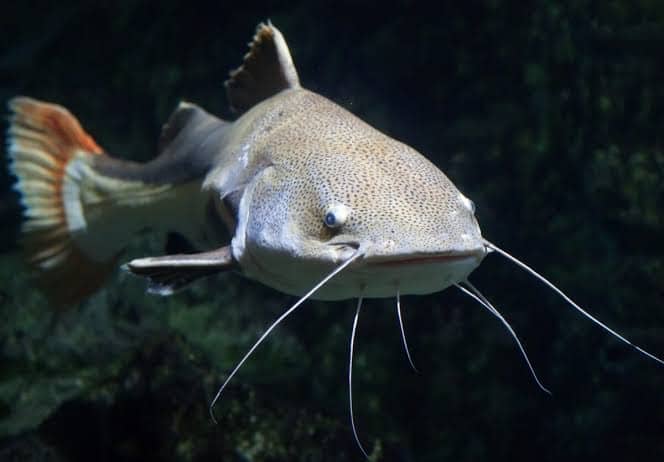If you are a seafood enthusiast or simply looking to expand your culinary horizons, exploring the flavours of different fish can be an exciting journey. One fish that has got everyone talking about its taste is the mighty catfish.
[ninja_tables id=”68506″]
Catfish is a popular seafood that can be found in most cuisines around the world. For centuries, this fish has been eaten in North America, Europe, Asia, and Africa alike. Whether it’s grilled, fried, or baked, catfish has a unique flavour that is sure to tantalise your taste buds.
However, not everyone falls head over heels for catfish. While some folks absolutely adore its taste, others aren’t big fans. If you have decided to try catfish, you might have scoured the internet to know more about its taste profile. But what did you find? Loads of multiple opinions about catfish and their taste, and it can be pretty confusing.
You know what? I was also pretty puzzled too not until I tried catfish myself. So, I’m writing this article to clear up any misconceptions and spill the beans on the truth about the question: “what does catfish taste like?” So together, we’ll explore what makes this fish so tasty and why some folks can’t get enough of it while others prefer different flavours.
What Is Catfish?
Catfish or catfishes are a diverse group of ray-finned fishes that belong to the order Siluriformes and are characterised by their long whisker-like barbels, which resemble the whiskers of a cat. These barbels are located around their mouth and it acts as a sensory organ which helps them taste food and feel around in their environment.

Catfish come in various species, with the most commonly consumed ones being channel catfish, blue catfish, and flathead catfish. These creatures can live in several water conditions, with various species living in brackish water, freshwater, and saltwater environments.
These fish have a unique appearance with smooth yet slimy skin that range in colour from greyish-brown to olive-brown. Some species may even have spots or mottled patterns on their bodies. Their slippery outer layer helps them glide through the water effortlessly.
In terms of behaviour, they are bottom-dwellers, meaning they live near the bottom of rivers, lakes, ponds or streams and primarily feed on other smaller fish or aquatic organisms like insects, crustaceans, and plants. Their diet contributes significantly to their taste profile.
What Does Catfish Taste Like?
To be honest, describing flavours can be a little tricky since everyone tastes things differently. But, I’ll try my best to tell you what catfish tastes like based on what I’ve experienced.
So, catfish has a white flesh that tastes mild and has a slightly sweet flavour. However, the taste of catfish can vary depending on whether it is wild-caught or farm-raised.
Some people say that the farm-raised catfish tastes even better than the wild ones. Why? Well, the wild ones sometimes have a bit of an earthy taste, like a hint of mud, and not everyone likes that. But the farm-raised catfish, on the other hand, tastes cleaner and fresher because they live in a controlled environment.
If you’re just starting to try catfish, I’d suggest going for the farm-raised kind, as the wild ones’ taste might not be for everyone.
Let’s not forget about the texture! Catfish is firm, but also tender and moist. When you cook it, you’ll see large flakes that break apart easily, making it really tasty.
When it comes to seasoning, catfish pairs well with a wide range of flavours. You can marinate it with citrus or vinegar-based marinades for added tanginess or use spices like paprika, garlic powder, or Cajun seasoning for some heat.
So, in a nutshell, catfish tastes mild and slightly sweet, and it can have different flavours depending on where it’s from—wild or farm-raised. The texture is firm yet tender and moist, making it perfect for all sorts of cooking styles.
Why Does My Catfish Taste Muddy?
If you’ve ever taken a bite of catfish only to be met with an unpleasant, muddy taste, there is no doubt it’s actually a wild catfish. But what causes this and how can I avoid it? Keep reading!
Catfish which are bottom feeders live in freshwater environments such as rivers and lakes where they scavenge for food on the riverbed or lake floor. These catfish have very poor eyesight and aren’t very picky in what they eat.
This means that they often consume algae, plants, insects, decaying matter and even mud found in their habitat. Hence, the wild-caught catfish will possess a muddy taste to it. This muddy taste is often concentrated around the fish’s stomach region.
To minimise the muddiness when cooking catfish at home, there are steps you can take.
- First and foremost is choosing your source wisely – opt for farm-raised catfish instead of wild-caught if possible. Farm-raised varieties tend to have cleaner flavours since they are raised in controlled environments and are fed with grains.
- Another tip is to soak your catfish fillets in milk before cooking them. The lactic acid helps neutralise any strong flavours while adding a subtle creaminess to enhance overall taste.
- Finally yet importantly is properly cleaning your catch before preparing it for consumption. Thoroughly rinse fresh-caught fish under cold running water while gently scrubbing away any visible dirt or mud on its skin.
What Are The Nutritional Value of Catfish?
Catfish is not only delicious but also a nutritious fish that offers various health benefits.
- For starters, It is rich in protein, which is essential for building and repairing tissues in our body. A 3-ounce serving of catfish provides approximately 15 grams of high-quality protein.
- In addition to being a good source of protein, catfish is low in calories and contains minimal amounts of saturated fat. This makes it an excellent choice for those who are watching their weight or trying to maintain a healthy lifestyle.
- Catfish also provides important vitamins and minerals such as vitamin B12, vitamin D, selenium, phosphorus, and potassium. These nutrients play crucial roles in promoting proper brain function, supporting bone health, boosting the immune system, and maintaining healthy blood pressure levels.
- Furthermore, catfish contains omega-3 fatty acids which are known for their anti-inflammatory properties and potential cardiovascular benefits. Omega-3s have been linked to reducing the risk of heart disease and improving overall heart health.
Can You Eat Catfish Raw?
Can you eat catfish raw? The short answer is yes, you can technically eat catfish raw. However, it’s important to consider a few factors before deciding to consume it this way.
Raw seafood carries the risk of bacterial or parasitic contamination, and catfish is no exception. Consuming raw catfish increases your chances of foodborne illnesses such as salmonella or E.coli infections. To minimise these risks, it’s crucial to ensure the freshness and quality of the fish.
If you’re determined to try eating raw catfish, make sure you source it from a reputable supplier who follows strict handling and storage practices. It should also be extremely fresh, ideally caught on the same day or frozen at sea.
To enhance safety further, some people choose to freeze their catfish for sushi-grade consumption. Freezing at temperatures below -4°F (-20°C) for at least seven days kills most parasites that may be present in the fish.
Regardless of whether you prefer your catfish cooked or raw, always prioritise your health by following proper food safety guidelines.
How to Choose the Best Catfish for Cooking
When it comes to cooking catfish, choosing the right one is key to achieving a delicious and satisfying meal. So how do you choose the best catfish for cooking? Here are some tips to help you make the right choice.

First and foremost, freshness is crucial. Look for catfish that have bright, clear eyes and shiny skin. Avoid fish with dull or cloudy eyes, as this could be a sign of poor quality or age.
Another factor to consider is the source of the catfish. Farm-raised catfish raised in clean, freshwater environments tend to have a milder flavour and firmer texture compared to their wild counterparts. If you prefer a more delicate taste, go for farm-raised catfish. On the other hand, if you’re after a stronger flavour profile, opt for wild-caught varieties.
Size matters too! Smaller catfish often have sweeter meat and are more tender when cooked. On the other hand, larger catfish may have stronger flavours but can sometimes be tougher in texture.
By keeping these considerations in mind when selecting your next batch of catfish for cooking, you’ll be well on your way to creating a mouthwatering meal that will leave everyone asking for seconds!
How to Clean Catfish?
Cleaning catfish is an essential step before cooking or filleting the fish. It helps remove any dirt, slime, or impurities that may affect its taste and texture.
Here’s a simple guide on how to clean catfish:
- Gather your tools: You’ll need a sharp knife, cutting board, water source (preferably running water), and a container for discarding waste.
- Rinse the fish: Start by rinsing the catfish under cold running water to remove any loose scales or debris.
- Remove outer layer: Using a knife, gently scrape off the slimy outer layer of the fish’s skin along with any remaining scales.
- Gutting: Make an incision along the belly from head to tail using a sharp knife. Reach in and carefully remove all internal organs from the cavity.
- Wash again: Rinse both inside and outside of the cleaned catfish thoroughly under running water to ensure it is completely free of any blood or residue.
Remember, proper cleaning ensures that your catfish tastes fresh and delicious when cooked!
How to Fillet Catfish?
Filleting a catfish can seem like a daunting task, but with the right technique and some practice, it can be done easily.
Here’s how you can fillet catfish like a pro.
- First, make sure you have a sharp filleting knife and a clean cutting surface. Lay the catfish on its side and hold it firmly by the head. With your knife, make an incision just behind the pectoral fin and cut all the way down to the tail fun area.
- Next, use long smooth strokes to remove the skin from one side of the fish. Start at the tail end and work your way up towards the head. Be careful not to cut through or puncture any organs as you do this.
- Once you’ve removed one side of skin, flip over the fish and repeat on the other side. The goal is to separate both sides of flesh from their corresponding rib bones.
- To finish off, remove any remaining small bones along each fillet using tweezers or pliers. This will ensure that your fillets are bone-free before cooking.
Remember, practice makes perfect when it comes to filleting catfish. Don’t get discouraged if your first attempts aren’t perfect – keep practising and soon enough you’ll be able to master this skill effortlessly!
How To Cook Catfish?
Cooking catfish is not only delicious but also quite easy. There are various methods you can use to cook catfish, depending on your preference and available ingredients.
Here are a few popular cooking techniques for preparing this tasty fish:
- Pan-Frying: Start by dipping the catfish fillets in a mixture of beaten eggs and milk, then coat them with seasoned cornmeal or flour. Heat oil in a skillet over medium-high heat and fry the fillets until they are golden brown on both sides.
- Grilling: Preheat your grill to medium-high heat and lightly oil the grates to prevent sticking. Season the catfish fillets with salt, pepper, and any other desired spices or herbs. Place the fillets directly on the grill grates and cook for about 4-5 minutes per side until they are opaque and flaky.
- Baking: Preheat your oven to around 375°F (190°C). Season the catfish fillets with salt, pepper, lemon juice, garlic powder, or any other preferred seasonings. Place them on a greased baking sheet or dish and bake for approximately 15-20 minutes until cooked through.
- Blackened: To create that signature blackened flavour, generously coat both sides of each catfish fillet with Cajun seasoning or a mix of paprika, cayenne pepper, thyme, oregano,and garlic powder blended together. Heat up some butter in a skillet over high heat until it begins to smoke slightly. Then add the seasoned fish fillets one at a time into the hot skillet. Cook each side for about 2-3 minutes making sure it’s charred.
Remember that these cooking times may vary depending on how thick your fish is; so always keep an eye out while cooking! Once done properly, you’ll be left with moist, fork-tender flesh that is sure to tantalise your taste buds.
Final Verdict
Catfish is a versatile and delicious fish that offers a unique taste experience. Whether you prefer a mild and delicate flavour or enjoy the earthy richness of freshwater fish, catfish has something to offer every palate.
Remember to choose your catfish wisely when purchasing. Look for fresh fillets that are firm with no off-putting odour. Opt for farm-raised varieties if you prefer milder flavours or go for wild-caught ones if you want a stronger taste profile.
So next time someone asks “What does catfish taste like?” confidently share your knowledge about this delectable fish knowing that it offers an exciting blend of flavours waiting to be explored by adventurous food lovers like yourself!







